- class QRectF#
The
QRectFclass defines a finite rectangle in the plane using floating point precision. More…Synopsis#
Methods#
def
__init__()def
__reduce__()def
__repr__()def
adjust()def
adjusted()def
bottom()def
bottomLeft()def
bottomRight()def
center()def
contains()def
getCoords()def
getRect()def
height()def
intersected()def
intersects()def
isEmpty()def
isNull()def
isValid()def
left()def
marginsAdded()def
marginsRemoved()def
moveBottom()def
moveBottomLeft()def
moveCenter()def
moveLeft()def
moveRight()def
moveTo()def
moveTop()def
moveTopLeft()def
moveTopRight()def
normalized()def
__ne__()def
__and__()def
__iand__()def
__add__()def
__iadd__()def
__sub__()def
__isub__()def
__eq__()def
__or__()def
__ior__()def
right()def
setBottom()def
setBottomLeft()def
setBottomRight()def
setCoords()def
setHeight()def
setLeft()def
setRect()def
setRight()def
setSize()def
setTop()def
setTopLeft()def
setTopRight()def
setWidth()def
setX()def
setY()def
size()def
toAlignedRect()def
toRect()def
top()def
topLeft()def
topRight()def
translate()def
translated()def
transposed()def
united()def
width()def
x()def
y()
Note
This documentation may contain snippets that were automatically translated from C++ to Python. We always welcome contributions to the snippet translation. If you see an issue with the translation, you can also let us know by creating a ticket on https:/bugreports.qt.io/projects/PYSIDE
Detailed Description#
Warning
This section contains snippets that were automatically translated from C++ to Python and may contain errors.
A rectangle is normally expressed as a top-left corner and a size. The size (width and height) of a
QRectFis always equivalent to the mathematical rectangle that forms the basis for its rendering.A
QRectFcan be constructed with a set of left, top, width and height coordinates, or from aQPointFand aQSizeF. The following code creates two identical rectangles.r1 = QRectF(100.0, 200.1, 11.2, 16.3) r2 = QRectF(QPointF(100.0, 200.1), QSizeF(11.2, 16.3))
There is also a third constructor creating a
QRectFfrom aQRect, and a correspondingtoRect()function that returns aQRectobject based on the values of this rectangle (note that the coordinates in the returned rectangle are rounded to the nearest integer).The
QRectFclass provides a collection of functions that return the various rectangle coordinates, and enable manipulation of these.QRectFalso provides functions to move the rectangle relative to the various coordinates. In addition there is amoveTo()function that moves the rectangle, leaving its top left corner at the given coordinates. Alternatively, thetranslate()function moves the rectangle the given offset relative to the current position, and thetranslated()function returns a translated copy of this rectangle.The
size()function returns the rectangle’s dimensions as aQSizeF. The dimensions can also be retrieved separately using thewidth()andheight()functions. To manipulate the dimensions use thesetSize(),setWidth()orsetHeight()functions. Alternatively, the size can be changed by applying either of the functions setting the rectangle coordinates, for example,setBottom()orsetRight().The
contains()function tells whether a given point is inside the rectangle or not, and theintersects()function returnstrueif this rectangle intersects with a given rectangle (otherwise false). TheQRectFclass also provides theintersected()function which returns the intersection rectangle, and theunited()function which returns the rectangle that encloses the given rectangle and this:The
isEmpty()function returnstrueif the rectangle’s width or height is less than, or equal to, 0. Note that an empty rectangle is not valid: TheisValid()function returnstrueif both width and height is larger than 0. A null rectangle (isNull()== true) on the other hand, has both width and height set to 0.Note that due to the way
QRectandQRectFare defined, an emptyQRectFis defined in essentially the same way asQRect.Finally,
QRectFobjects can be streamed as well as compared.Rendering#
When using an anti-aliased painter, the boundary line of a
QRectFwill be rendered symmetrically on both sides of the mathematical rectangle’s boundary line. But when using an aliased painter (the default) other rules apply.Then, when rendering with a one pixel wide pen the
QRectF‘s boundary line will be rendered to the right and below the mathematical rectangle’s boundary line.When rendering with a two pixels wide pen the boundary line will be split in the middle by the mathematical rectangle. This will be the case whenever the pen is set to an even number of pixels, while rendering with a pen with an odd number of pixels, the spare pixel will be rendered to the right and below the mathematical rectangle as in the one pixel case.
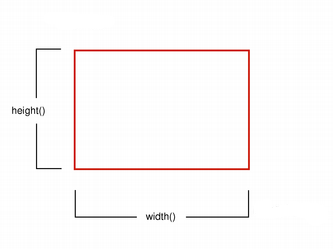
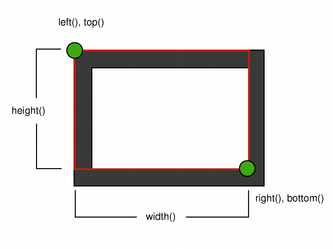
Logical representation
One pixel wide pen
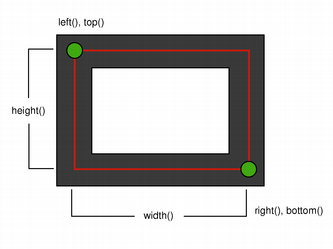
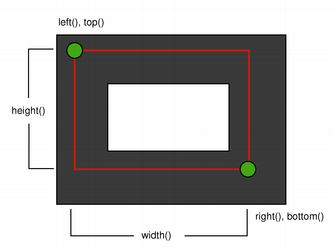
Two pixel wide pen
Three pixel wide pen
Coordinates#
The
QRectFclass provides a collection of functions that return the various rectangle coordinates, and enable manipulation of these.QRectFalso provides functions to move the rectangle relative to the various coordinates.For example: the
bottom(),setBottom()andmoveBottom()functions:bottom()returns the y-coordinate of the rectangle’s bottom edge,setBottom()sets the bottom edge of the rectangle to the given y coordinate (it may change the height, but will never change the rectangle’s top edge) andmoveBottom()moves the entire rectangle vertically, leaving the rectangle’s bottom edge at the given y coordinate and its size unchanged.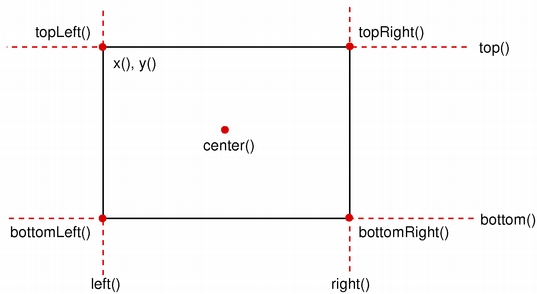
It is also possible to add offsets to this rectangle’s coordinates using the
adjust()function, as well as retrieve a new rectangle based on adjustments of the original one using theadjusted()function. If either of the width and height is negative, use thenormalized()function to retrieve a rectangle where the corners are swapped.In addition,
QRectFprovides thegetCoords()function which extracts the position of the rectangle’s top-left and bottom-right corner, and thegetRect()function which extracts the rectangle’s top-left corner, width and height. Use thesetCoords()andsetRect()function to manipulate the rectangle’s coordinates and dimensions in one go.Constructs a rectangle with the given
topLeftandbottomRightcorners.See also
- __init__()
Constructs a null rectangle.
See also
- __init__(left, top, width, height)
- Parameters:
left – float
top – float
width – float
height – float
Constructs a rectangle with (
x,y) as its top-left corner and the givenwidthandheight. All parameters must be finite.See also
Constructs a rectangle with the given
topLeftcorner and the givensize.See also
- __init__(rect)
- Parameters:
rect –
QRect
Constructs a
QRectFrectangle from the givenQRectrectangle.Note
This function, like
toRectF(), preserves thesize()ofrectangle, not itsbottomRight()corner.- __reduce__()#
- Return type:
object
- __repr__()#
- Return type:
object
- adjust(x1, y1, x2, y2)#
- Parameters:
x1 – float
y1 – float
x2 – float
y2 – float
Adds
dx1,dy1,dx2anddy2respectively to the existing coordinates of the rectangle. All parameters must be finite.See also
- adjusted(x1, y1, x2, y2)#
- Parameters:
x1 – float
y1 – float
x2 – float
y2 – float
- Return type:
Returns a new rectangle with
dx1,dy1,dx2anddy2added respectively to the existing coordinates of this rectangle. All parameters must be finite.See also
- bottom()#
- Return type:
float
Returns the y-coordinate of the rectangle’s bottom edge.
See also
Returns the position of the rectangle’s bottom-left corner.
See also
Returns the position of the rectangle’s bottom-right corner.
See also
Returns the center point of the rectangle.
See also
This is an overloaded function.
Returns
trueif the givenrectangleis inside this rectangle; otherwise returnsfalse.- contains(x, y)
- Parameters:
x – float
y – float
- Return type:
bool
This is an overloaded function.
Returns
trueif the point (x,y) is inside or on the edge of the rectangle; otherwise returnsfalse.- contains(p)
- Parameters:
p –
QPointF- Return type:
bool
Returns
trueif the givenpointis inside or on the edge of the rectangle; otherwise returnsfalse.See also
- getCoords()#
- Return type:
PyObject
Extracts the position of the rectangle’s top-left corner to *``x1`` and *``y1``, and the position of the bottom-right corner to *``x2`` and *``y2``.
See also
- getRect()#
- Return type:
PyObject
Extracts the position of the rectangle’s top-left corner to *``x`` and *``y``, and its dimensions to *``width`` and *``height``.
See also
- height()#
- Return type:
float
Returns the height of the rectangle.
See also
Returns the intersection of this rectangle and the given
rectangle. Note thatr.intersected(s)is equivalent tor & s.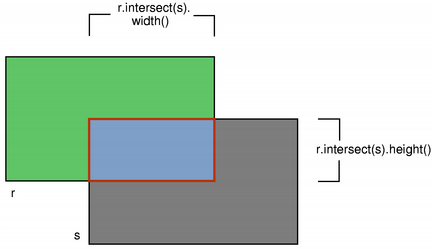
See also
intersects()united()operator&=()Returns
trueif this rectangle intersects with the givenrectangle(i.e. there is a non-empty area of overlap between them), otherwise returnsfalse.The intersection rectangle can be retrieved using the
intersected()function.See also
- isEmpty()#
- Return type:
bool
Returns
trueif the rectangle is empty, otherwise returnsfalse.An empty rectangle has
width()<= 0 orheight()<= 0. An empty rectangle is not valid (i.e., isEmpty() == !isValid()).Use the
normalized()function to retrieve a rectangle where the corners are swapped.See also
- isNull()#
- Return type:
bool
Returns
trueif the rectangle is a null rectangle, otherwise returnsfalse.A null rectangle has both the width and the height set to 0. A null rectangle is also empty, and hence not valid.
- isValid()#
- Return type:
bool
Returns
trueif the rectangle is valid, otherwise returnsfalse.A valid rectangle has a
width()> 0 andheight()> 0. Note that non-trivial operations like intersections are not defined for invalid rectangles. A valid rectangle is not empty (i.e., isValid() == !isEmpty()).See also
- left()#
- Return type:
float
Returns the x-coordinate of the rectangle’s left edge. Equivalent to
x().See also
Returns a rectangle grown by the
margins.See also
operator+=()marginsRemoved()operator-=()Removes the
marginsfrom the rectangle, shrinking it.See also
marginsAdded()operator+=()operator-=()- moveBottom(pos)#
- Parameters:
pos – float
Moves the rectangle vertically, leaving the rectangle’s bottom edge at the given finite
ycoordinate. The rectangle’s size is unchanged.See also
Moves the rectangle, leaving the bottom-left corner at the given
position. The rectangle’s size is unchanged.See also
Moves the rectangle, leaving the bottom-right corner at the given
position. The rectangle’s size is unchanged.See also
Moves the rectangle, leaving the center point at the given
position. The rectangle’s size is unchanged.See also
- moveLeft(pos)#
- Parameters:
pos – float
Moves the rectangle horizontally, leaving the rectangle’s left edge at the given finite
xcoordinate. The rectangle’s size is unchanged.See also
- moveRight(pos)#
- Parameters:
pos – float
Moves the rectangle horizontally, leaving the rectangle’s right edge at the given finite
xcoordinate. The rectangle’s size is unchanged.See also
This is an overloaded function.
Moves the rectangle, leaving the top-left corner at the given
position.- moveTo(x, y)
- Parameters:
x – float
y – float
Moves the rectangle, leaving the top-left corner at the given position (
x,y). The rectangle’s size is unchanged. Both parameters must be finite.See also
- moveTop(pos)#
- Parameters:
pos – float
Moves the rectangle vertically, leaving the rectangle’s top line at the given finite
ycoordinate. The rectangle’s size is unchanged.See also
Moves the rectangle, leaving the top-left corner at the given
position. The rectangle’s size is unchanged.See also
Moves the rectangle, leaving the top-right corner at the given
position. The rectangle’s size is unchanged.See also
Returns a normalized rectangle; i.e., a rectangle that has a non-negative width and height.
If
width()< 0 the function swaps the left and right corners, and it swaps the top and bottom corners ifheight()< 0.Returns
trueif the rectanglesr1andr2are sufficiently different, otherwise returnsfalse.Warning
This function does not check for strict inequality; instead, it uses a fuzzy comparison to compare the rectangles’ coordinates.
Returns the intersection of this rectangle and the given
rectangle. Returns an empty rectangle if there is no intersection.See also
operator&=()intersected()Intersects this rectangle with the given
rectangle.See also
intersected()operator&()This is an overloaded function.
Returns the
lhsrectangle grown by therhsmargins.Returns the
lhsrectangle grown by therhsmargins.Adds the
marginsto the rectangle, growing it.See also
marginsAdded()marginsRemoved()operator-=()Returns the
lhsrectangle shrunk by therhsmargins.Returns a rectangle shrunk by the
margins.See also
marginsRemoved()operator+=()marginsAdded()Returns
trueif the rectanglesr1andr2are approximately equal, otherwise returnsfalse.Warning
This function does not check for strict equality; instead, it uses a fuzzy comparison to compare the rectangles’ coordinates.
See also
qFuzzyCompareReturns the bounding rectangle of this rectangle and the given
rectangle.See also
united()operator|=()Unites this rectangle with the given
rectangle.See also
united()operator|()- right()#
- Return type:
float
Returns the x-coordinate of the rectangle’s right edge.
See also
- setBottom(pos)#
- Parameters:
pos – float
Sets the bottom edge of the rectangle to the given finite
ycoordinate. May change the height, but will never change the top edge of the rectangle.See also
Set the bottom-left corner of the rectangle to the given
position. May change the size, but will never change the top-right corner of the rectangle.See also
Set the bottom-right corner of the rectangle to the given
position. May change the size, but will never change the top-left corner of the rectangle.See also
- setCoords(x1, y1, x2, y2)#
- Parameters:
x1 – float
y1 – float
x2 – float
y2 – float
Sets the coordinates of the rectangle’s top-left corner to (
x1,y1), and the coordinates of its bottom-right corner to (x2,y2). All parameters must be finite.See also
- setHeight(h)#
- Parameters:
h – float
Sets the height of the rectangle to the given finite
height. The bottom edge is changed, but not the top one.- setLeft(pos)#
- Parameters:
pos – float
Sets the left edge of the rectangle to the given finite
xcoordinate. May change the width, but will never change the right edge of the rectangle.Equivalent to
setX().See also
- setRect(x, y, w, h)#
- Parameters:
x – float
y – float
w – float
h – float
Sets the coordinates of the rectangle’s top-left corner to (
x,y), and its size to the givenwidthandheight. All parameters must be finite.See also
- setRight(pos)#
- Parameters:
pos – float
Sets the right edge of the rectangle to the given finite
xcoordinate. May change the width, but will never change the left edge of the rectangle.See also
Sets the size of the rectangle to the given finite
size. The top-left corner is not moved.See also
- setTop(pos)#
- Parameters:
pos – float
Sets the top edge of the rectangle to the given finite
ycoordinate. May change the height, but will never change the bottom edge of the rectangle.Equivalent to
setY().Set the top-left corner of the rectangle to the given
position. May change the size, but will never change the bottom-right corner of the rectangle.See also
Set the top-right corner of the rectangle to the given
position. May change the size, but will never change the bottom-left corner of the rectangle.See also
- setWidth(w)#
- Parameters:
w – float
Sets the width of the rectangle to the given finite
width. The right edge is changed, but not the left one.- setX(pos)#
- Parameters:
pos – float
Sets the left edge of the rectangle to the given finite
xcoordinate. May change the width, but will never change the right edge of the rectangle.Equivalent to
setLeft().See also
- setY(pos)#
- Parameters:
pos – float
Sets the top edge of the rectangle to the given finite
ycoordinate. May change the height, but will never change the bottom edge of the rectangle.Equivalent to
setTop().See also
Returns the size of the rectangle.
Returns a
QRectbased on the values of this rectangle that is the smallest possible integer rectangle that completely contains this rectangle.See also
Returns a
QRectbased on the values of this rectangle. Note that the coordinates in the returned rectangle are rounded to the nearest integer.See also
QRectF()toAlignedRect()toRectF()- top()#
- Return type:
float
Returns the y-coordinate of the rectangle’s top edge. Equivalent to
y().See also
Returns the position of the rectangle’s top-left corner.
See also
Returns the position of the rectangle’s top-right corner.
See also
This is an overloaded function.
Moves the rectangle
offset.x()along the x axis andoffset.y()along the y axis, relative to the current position.- translate(dx, dy)
- Parameters:
dx – float
dy – float
Moves the rectangle
dxalong the x-axis anddyalong the y-axis, relative to the current position. Positive values move the rectangle to the right and downwards. Both parameters must be finite.See also
This is an overloaded function.
Returns a copy of the rectangle that is translated
offset.x()along the x axis andoffset.y()along the y axis, relative to the current position.- translated(dx, dy)
- Parameters:
dx – float
dy – float
- Return type:
Returns a copy of the rectangle that is translated
dxalong the x axis anddyalong the y axis, relative to the current position. Positive values move the rectangle to the right and down. Both parameters must be finite.See also
Warning
This section contains snippets that were automatically translated from C++ to Python and may contain errors.
Returns a copy of the rectangle that has its width and height exchanged:
r = {1.5, 5.1, 4.2, 2.4} r = r.transposed() # r == {1.5, 5.1, 2.4, 4.2}
See also
Returns the bounding rectangle of this rectangle and the given
rectangle.
See also
- width()#
- Return type:
float
Returns the width of the rectangle.
See also
- x()#
- Return type:
float
Returns the x-coordinate of the rectangle’s left edge. Equivalent to
left().- y()#
- Return type:
float
Returns the y-coordinate of the rectangle’s top edge. Equivalent to
top().